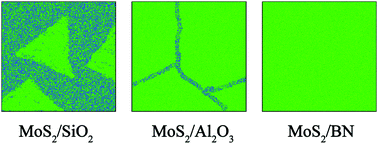Destructive role of oxygen in growth of molybdenum disulfide determined by secondary ion mass spectrometry
Abstract
The application of secondary ion mass spectrometry (SIMS) in investigation and comparison of molybdenum disulfide (MoS2) films grown on SiO2, Al2O3 and BN substrates is presented. SIMS measurements of the MoS2/substrate interface reveals oxygen out-diffusion from the substrates containing oxygen and the formation of an amorphous MoOS layer in addition to MoS2. The total area of MoS2 domains covering the substrate is directly related to the type of substrate. For SiO2, small triangular domains of MoS2 separated by amorphous MoOS material are observed. For Al2O3, the sizes of the MoS2 domains are drastically improved due to the higher stability of sapphire. For a BN substrate, SIMS measurements reveal a uniform MoS2 coverage over the whole 2-inch wafer. These results show the destructive role of oxygen released from substrates such as SiO2 or Al2O3 during the growth process of MoS2. The fast and cheap growth process on a non-oxide substrate allows large wafer-scale uniform molybdenum disulfide material to be obtained, which is promising for device fabrication.



 Please wait while we load your content...
Please wait while we load your content...